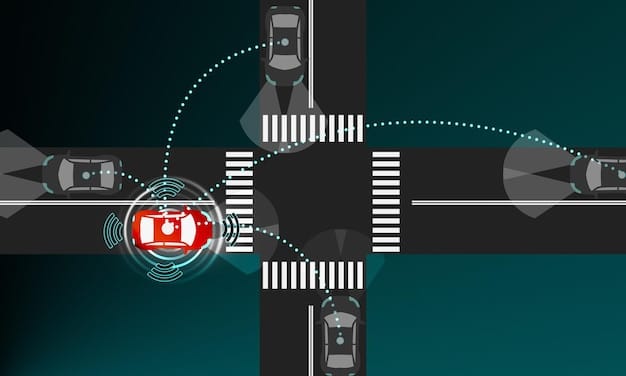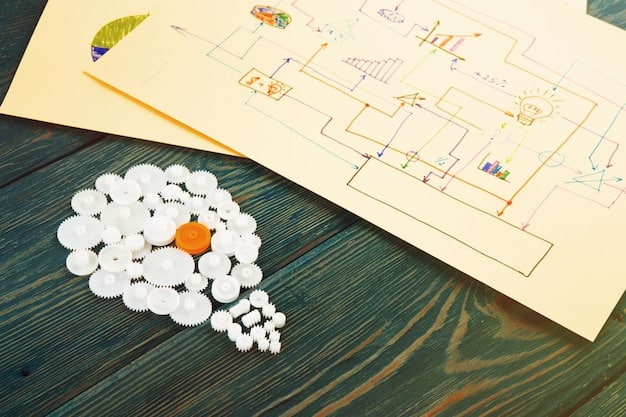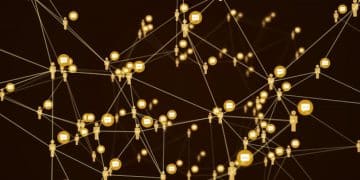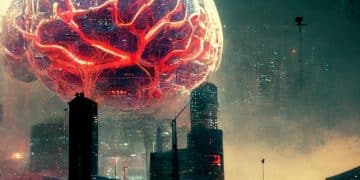AI and Intellectual Property: Navigating the US Legal Maze

AI and intellectual property (IP) are converging, creating a complex legal landscape in the US, prompting critical questions about ownership, infringement, and the role of AI in innovation.
The intersection of AI and intellectual property: navigating the complex legal landscape in the US is rapidly evolving, presenting novel challenges for creators, businesses, and policymakers alike. Understanding these challenges is crucial for fostering innovation while protecting intellectual property rights.
Understanding the Basics of AI and IP Law
Artificial intelligence (AI) is no longer a futuristic concept; it’s a present-day reality impacting various sectors. Simultaneously, intellectual property (IP) law in the US is designed to protect creativity and innovation. The complex interplay between these two fields requires a foundational understanding of both.
What is Artificial Intelligence?
AI refers to the ability of machines to perform tasks that typically require human intelligence, such as learning, problem-solving, and decision-making. AI systems can range from simple algorithms to complex neural networks.
Key Aspects of US Intellectual Property Law
IP law encompasses several types of legal protections, each with its own criteria and scope. Understanding these is vital when assessing AI’s impact.
- Copyright: Protects original works of authorship, including literary, dramatic, musical, and certain other intellectual works.
- Patents: Grant inventors exclusive rights to their inventions, allowing them to exclude others from making, using, or selling the invention for a set period.
- Trademarks: Protect brand names and logos used to identify and distinguish goods or services of one party from those of others.
The convergence of AI and IP law in the US raises essential questions for protecting innovation and creativity. As AI systems become more sophisticated, the legal framework needs to adapt to address the challenges and opportunities presented by this technological advancement.

AI-Generated Content: Authorship and Ownership Dilemmas
One of the most pressing legal questions revolves around AI-generated content. If an AI creates a work, who owns the copyright? This question has implications for artists, developers, and businesses leveraging AI for content creation.
The Copyright Office’s Stance on AI Authorship
The US Copyright Office has taken a firm stance, asserting that copyright protection applies only to works created by human beings. Works generated solely by AI are not eligible for copyright protection under current US law.
Scenarios and Implications
Consider these scenarios to understand the implications of this stance:
- AI as a Tool: If a human uses AI as a tool to create a work, with significant human input and creative control, the resulting work may be copyrightable.
- AI as Sole Creator: If an AI generates a work autonomously, without significant human intervention, the work is unlikely to be eligible for copyright protection.
- Mixed Creation: Determining the degree of human involvement necessary for copyright protection remains a gray area and is subject to legal interpretation.
The debate over AI authorship and ownership is far from settled. Legal scholars and practitioners are actively discussing how to adapt existing copyright law to address the unique challenges posed by AI-generated content. A consensus may eventually emerge from ongoing discussions and legal decisions.
Patent Law and AI: Inventorship Challenges
In the realm of patent law, AI raises questions about inventorship. Can an AI be listed as an inventor on a patent application? This is a critical question as AI becomes more involved in the inventive process.

Current Legal Framework
Under current US patent law, inventorship is generally reserved for natural persons. The law defines an inventor as an individual who conceives the invention, and machines, including AI, do not qualify as inventors.
The DABUS Case
The DABUS (Device for the Autonomous Bootstrapping of Unified Sentience) case brought by Dr. Stephen Thaler challenges the conventional understanding of inventorship. Thaler sought to patent inventions created by his AI system, DABUS, listing the AI as the inventor.
The outcome of the DABUS case underscores the prevailing view that inventorship is tied to human ingenuity. The legal system’s interpretation of inventorship remains anchored to human contributions, rather than AI’s capacity for innovation.
AI and Copyright Infringement: Navigating Liability
AI systems trained on copyrighted material may inadvertently infringe on those copyrights. Determining liability for such infringement raises complex questions about who is responsible and under what circumstances.
Training Data and Fair Use
The use of copyrighted material for training AI models often relies on the doctrine of fair use. Fair use allows the use of copyrighted material without permission for certain purposes, such as criticism, commentary, news reporting, teaching, scholarship, and research.
The application of fair use to AI training data is a subject of ongoing debate. Courts weigh several factors, including the purpose and character of the use, the nature of the copyrighted work, the amount and substantiality of the portion used, and the effect of the use upon the potential market for or value of the copyrighted work.
Potential Liabilities
Several parties could potentially be held liable for copyright infringement by AI systems:
- AI Developers: Those who design and develop AI systems.
- AI Trainers: Those who provide the data used to train AI systems.
- AI Users: Those who use AI systems to create infringing content.
Defining the scope of liability is a complex task. The key here is establishing whether direct infringement occurred. If it is determined that the use of AI resulted in the replication of a work without permission, then the court would have to define which party is culpable. It could be that the AI developer is not directly liable if the user prompts, or uses, the AI inappropriately.
Trade Secrets and AI: Protecting Confidential Information
Trade secrets, which include confidential information that provides a business with a competitive edge, are also affected by the rise of AI. AI systems can both help protect trade secrets and pose risks to their confidentiality.
Using AI to Protect Trade Secrets
AI can be used to monitor and detect potential trade secret theft or unauthorized access to confidential information. AI-powered systems can analyze data patterns and identify anomalies that may indicate a breach.
Risks to Trade Secrets
AI systems can also pose risks to trade secrets. For example, if an AI model is trained on confidential information, that information could be inadvertently disclosed through the model’s outputs.
Companies must implement robust security measures to protect their trade secrets from AI-related threats. These measures may include data encryption, access controls, and employee training on data security best practices. Careful consideration must be given to how AI systems are used and managed to prevent accidental disclosure of confidential information.
The Future of AI and IP Law in the US
The legal landscape surrounding AI and intellectual property is dynamic and evolving. Several key trends and developments are shaping the future of this field.
Policy and Legislative Initiatives
Policymakers and legislators are actively considering how to adapt existing IP laws to address the challenges posed by AI. New legislation or amendments to existing laws may be necessary to provide clearer guidance on issues such as authorship, inventorship, and liability.
Judicial Interpretations
Courts will play a crucial role in shaping the legal landscape through their interpretations of existing laws in the context of AI. Landmark cases, like the DABUS case, provide valuable insights into how courts are approaching these issues.
Ethical Considerations
Ethical considerations are increasingly important in the development and deployment of AI systems. Ensuring fairness, transparency, and accountability in AI decision-making are essential for building public trust and promoting responsible innovation.
| Key Concept | Brief Description |
|---|---|
| 🤖 AI Authorship | Copyright protections are typically only for human-created works, excluding AI-generated content. |
| 🧪 AI Inventorship | US patent law generally requires inventors to be natural persons, so AI cannot be listed as an inventor. |
| ⚖️ Infringement | AI training using copyrighted data raises questions whether or not it constitutes copyright Infringement. |
| 🔒 Trade Secrets | AI can pose a risk when training models using confidential data. |
FAQ
▼
No, based on the current stance of the US Copyright Office, only works created by human beings are eligible for copyright protection. AI can only be considered a tool.
▼
No, US patent law defines an inventor as an individual, and machines, including AI, do not qualify. Inventorship is generally reserved for natural persons.
▼
Fair use allows the use of copyrighted material without permission for purposes like research. Its application to AI training data is debated and depends on several factors.
▼
Potentially liable parties include AI developers, trainers, and users. Determining liability depends on factors such as the level of involvement and control.
▼
AI may inadvertently disclose or be used to steal trade secrets, and AI can also be helpful in monitoring suspicious activity. Companies must stay vigilant.
Conclusion
Navigating the complex legal landscape of AI and intellectual property in the USrequires a multifaceted understanding of copyright, patent, trade secret, and ethical considerations. As AI technologies continue to advance, ongoing policy, judicial, and ethical guidance will be essential for fostering innovation while respecting intellectual property rights.





